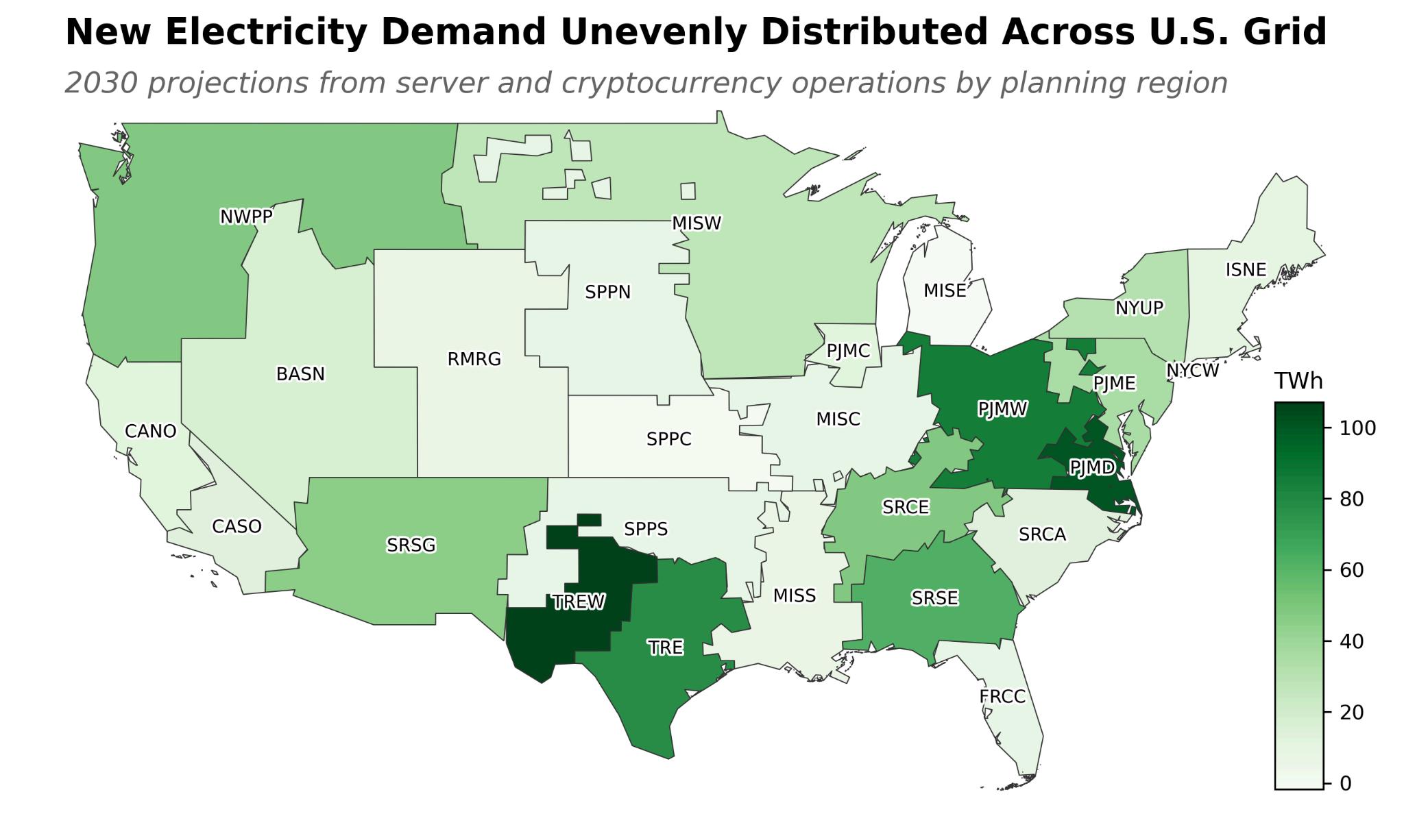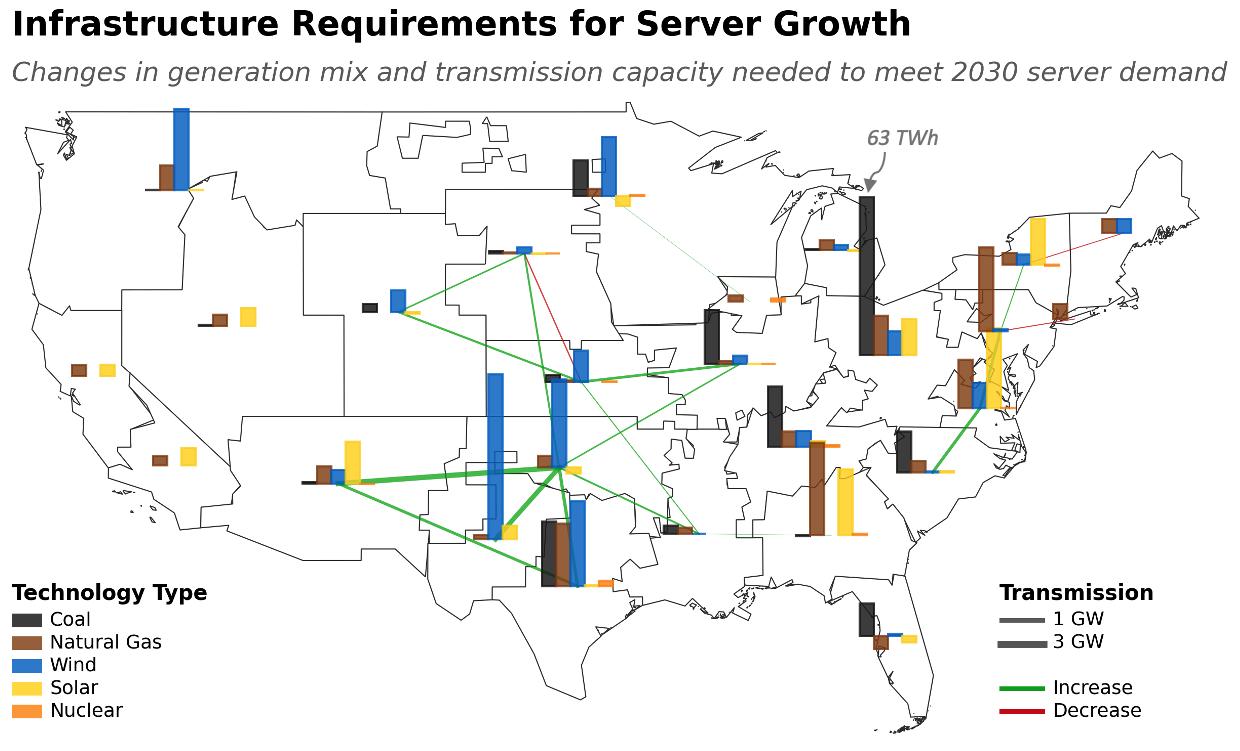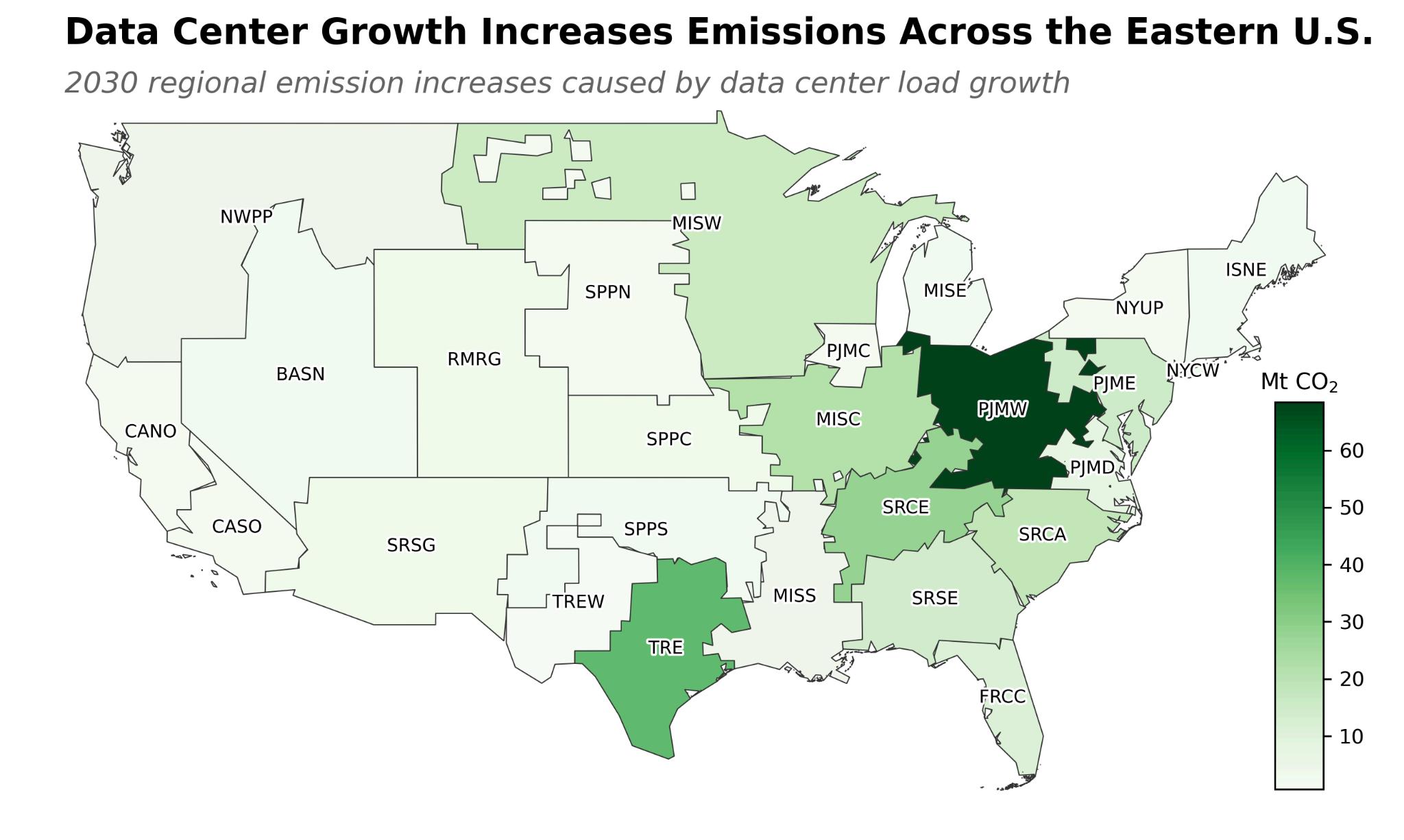Electricity Grid Impacts of Rising Demand from Data Centers and Cryptocurrency Mining Operations

June 2025


June 2025
In December 2024, capacity market clearing prices in PJM exploded from $30 to $270 per MW-day, a ninefold rise that will increase bills for 67 million customers across 13 states (Howland 2024). The increase provoked extraordinary pushback from state leaders: Pennsylvania sued PJM, Maryland passed emergency legislation, and Virginia's governor called for PJM’s CEO to be fired "PJM has lost the plot," New Jersey Governor Philip Murphy declared Maryland Governor Wes Moore stated, "I am angry" (Penn 2025)
Rapid and significant growth in electricity demand to power data centers and cryptocurrency mines is the suspected primary cause of this extreme price increase (Kearney 2024) Recent estimates indicate that data center and cryptocurrency mining electricity demand will increase by 350% between 2020 and 2030 (Shehabi et al. 2024) growing from 4% to 9% of national consumption (EPRI 2024). This growth requires careful planning to balance the potential benefits and costs of data centers and cryptocurrency mining

The Open Energy Outlook Initiative has modeled the implications of this growth under current policies and market structures, including the provisions of the Inflation Reduction Act at risk of rescission under the 119th Congress. Our results demonstrate that without policy intervention, this demand growth could increase wholesale electricity costs by 8% nationally and add 275 million metric tonnes per year of CO2 emissions by 2030 – matching the entire annual carbon output of France. However, these outcomes are not inevitable. This analysis models the infrastructure, economic, and environmental implications under current policies and summarizes policy tools that could ensure the grid accommodates this expansion while protecting consumers and climate goals
Our modeling projects that wholesale electricity costs, measured as demand-weighted marginal generation costs, could increase by an average of 8% nationally Central and Northern Virginia exemplify the challenge 1 Home to
1 Electric power operating regions cross state boundaries. The regional definitions correspond to the modeling framework used in this analysis; see Shively et al. (2025) for details.
the nation's largest data center concentration, the region is projected to require an additional 100 TWh of electricity by 2030 Our analysis shows that, under current policies, more than 25 GW of aging and costly coal plants would continue operating largely to meet the added electricity demands from data centers, plants that would otherwise be on track to retire This added generation drives a projected cost increase of more than 25% in Central and Northern Virginia the highest regional increase in the model Under these conditions, price spikes similar to those seen in the December 2024 PJM capacity market auction may become more common.

In most markets, increased generation costs are eventually passed on to all customers Electricity rates for residents in PJM states have already increased 23% to 40% over the past five years, with data center growth identified as a primary driver. As PJM's CEO acknowledged, "Prices are up because of tightening supply and demand driven by generator retirements and data center growth" (Penn 2025) Our analysis explains this dynamic: when regions with limited renewable resources face rapid demand growth, increasing generation from older coal plants - while expensive to operate - is still less expensive in the short-run than building new gas or nuclear capacity. Policy changes will be required to protect customers from disproportionately absorbing these costs
Under current policies, we project that electricity demand from data centers and cryptocurrency mining will increase power sector emissions by 30% in 2030 compared to projecting no demand growth for data centers, reaching approximately 275 million metric tonnes of CO2 annually by 2030 Our infrastructure analysis reveals different regional outcomes illustrated by comparing projections for Texas with PJM, which serves parts of the Mid-Atlantic and Midwest. In PJM, increased demand in PJMD is primarily met by coal and natural gas generation PJMD imports substantial natural gas from PJME and coal-fired electricity from PJMW, raising the emission intensity in PJMW from 0 42 to 0 48 metric tonnes CO₂ per MWh This reflects a form of carbon leakage, where emissions are produced in one region to meet electricity demand in another Emissions rise from generators in PJMW and PJME which together encompass all of Ohio, Pennsylvania, West Virginia, New Jersey, Maryland, Delaware, and Washington, D C , along with parts of surrounding states to serve growing demand in PJMD, which primarily includes parts of Virginia Such leakage can undermine state-level emissions
targets when in-state restrictions displace emissions rather than reduce them In contrast, Texas utilizes more wind generation from the grid to power data center operations through targeted transmission investments These contrasting outcomes underscore how regional resource availability and transmission influence emissions.

Traditional utility planning frameworks often assume gradual demand growth of 1-2% annually over multi-decade horizons. With localized growth rates of 20-30% annually, data center and cryptocurrency operations challenge existing planning capabilities and market realities Underscoring these challenges, the North American Electric Reliability Corporation anticipates resource adequacy concerns in multiple regions, warning that traditional reserve margin planning will lead to infrastructure shortfalls (NERC 2024). This challenge is compounded by the fragmented structure of U S electricity governance, where responses must be coordinated across vertically integrated utilities, competitive wholesale markets, and regional transmission organizations each operating under different regulatory frameworks and timelines
In vertically integrated utilities, new demand center connections far outpace the regulatory processes driving integrated resource planning and new generation approvals Whereas new demand connections occur over 18 to 24 months, integrated resource plans address planning across decades, and new generation approval requires 3 to 5 years This mismatch will continue to stress markets, increasing demand much faster than supply
Restructured markets face equally significant but different challenges. Market signals intended to incentivize new capacity development operate on multi-year cycles that cannot respond to sudden demand surges The PJM capacity market's price volatility illustrates how traditional market mechanisms struggle when confronted with unprecedented demand growth. This volatility deters the very investments needed to meet demand, as developers cannot rely on stable revenue projections

Recent state responses demonstrate the search for solutions Pennsylvania's intervention in the capacity market, Maryland's transparency legislation, and Virginia's efficiency standards represent different approaches to managing these challenges At the federal level, FERC finalized Order 2023 to address interconnection delays, but its reforms are only starting to take effect Queues remain historically long, with most projects still facing multi-year waits (Volcovici and Carr 2024)
These planning challenges require comprehensive policy responses that go beyond incremental adjustments to existing frameworks. While modeling policy strategies is beyond the scope of this memorandum, we summarize several strategies to accommodate digital infrastructure growth while managing costs and emissions
Cost Allocation and Rate Design: Ensuring large users fairly contribute to infrastructure costs prevents undue price burdens for all consumers Oregon (HB 3546), Utah (SB 132), and Illinois (through Clean Jobs Coalition proposals) have explored creating new customer classes with specific rate structures. Among many other measures, Texas (SB 6) requires revenue sharing from data centers and other large loads These mechanisms ensure that entities driving system expansion bear proportionate costs while maintaining incentives for efficient operations.
Strategic Siting and Clean Energy Integration: While data center location decisions prioritize low-latency fiber access and cooling water availability, policies can incentivize siting that minimizes grid impacts Some operators are exploring direct connections to carbon-free nuclear generation, either through extending the operational life of existing facilities or partnering on small modular reactor development. However, these approaches face significant regulatory timelines and financing challenges that require federal support to overcome
Transmission Planning Reform: Upgrading bulk power systems to connect renewable-rich regions with demand centers could fundamentally alter our projected outcomes However, current transmission planning and construction lag well behind the pace of demand growth. Reform must address permitting timelines, cost
allocation across multiple jurisdictions, and local opposition to new infrastructure The Inflation Reduction Act provides funding mechanisms that remain underutilized due to these procedural barriers and may be repealed by the 119th Congress.
Demand Flexibility Requirements: Data centers have traditionally been considered inflexible loads, operating at high utilization rates with stringent uptime requirements However, emerging research suggests that even limited flexibility could provide significant system benefits, though the technical feasibility remains uncertain (Norris et al 2025) Cryptocurrency mining operations may offer more flexibility than traditional data centers However, Texas SB 6 requires new data centers and other large loads to either curtail or utilize their onsite generation during emergency conditions Virginia's HB 116 takes a different approach, mandating efficiency standards for server installations to reduce baseline demand rather than relying on operational flexibility.
Proposed Federal Legislation: The proposed Clean Cloud Act of 2025 would include multiple regulatory strategies, including national reporting requirements, emissions standards, fees, and revenue-sharing mechanisms to support grid affordability and clean energy It would establish reporting standards and incentivize investments in energy efficiency and renewable power for digital infrastructure. The bill aims to align the rapid growth of cloud computing with national goals related to climate change and reducing dependence on fossil fuels While our analysis does not model the impacts of this regulation or assess its implementation feasibility, this bill highlights that there may be opportunities and interest for legislative action at the federal level.
Implementing these strategies will require a mix of policy tools, including revised transmission planning procedures, interconnection rules, zoning reform, permit reform, and financial incentives Success depends on coordination across local, state, and federal jurisdictions and between public and private sector actors
The rapid growth of data centers and cryptocurrency operations presents both challenges and opportunities for the U.S. electricity system. Our modeling demonstrates that continuation of current policies would result in higher costs and emissions, but these outcomes are not predetermined
The December 2024 PJM capacity auction serves as an important signal highlighting the need for proactive planning With appropriate, coordinated policy implementation at the federal, state, and local levels, the grid can accommodate digital economy growth while maintaining affordability and environmental progress.
The benefits of AI development and digital infrastructure are substantial, from medical breakthroughs to broader productivity gains Ensuring these advances do not come at the expense of affordable, clean electricity requires immediate attention to planning frameworks, cost allocation, and market design The choice should not be between digital progress and grid stability proper policies can help advance both.
Demands: We fit historical demand estimates and projections (2014–2028, Shehabi et al , 2024) to logistic growth models through 2050, assuming annual growth rates of 23% for data centers and 30% for cryptocurrency mining, with maximum demands of 1,200 TWh and 600 TWh, respectively Regional allocation used a combination of state-level consumption and capacity data, as well as balancing area projections (EPRI 2023; EIA 2024, Kou 2025).
Model: The Tools for Energy Model Optimization and Analysis (Temoa) modeling platform determined the least-cost generation and transmission solutions, incorporating current policies such as the Inflation Reduction Act provisions Full model configuration available in Shively et al (2025) Additional temporal scenarios are available upon request.
1 EPRI (Electric Power Research Institute) Powering Intelligence: Analyzing Artificial Intelligence and Data Center Energy Consumption. Published online 2024. https://wwwwprorg/wp-content/uploads/2024/06/3002028905 Powering-Intelligence -Analyzing-Artificial-Inte lligence-and-Data-Center-Energy-Consumption pdf
2 Howland E PJM capacity prices hit record highs, sending build signal to generators | Utility Dive July 31, 2024 Accessed June 25, 2025 https://www.utilitydive.com/news/pjm-interconnection-capacity-auction-vistra-constellation/722872/
3 Kearney L Pennsylvania governor complains to regulator about PJM’s power market rules Reuters https://wwwreuters com/business/energy/pennsylvania-governor-complains-regulator-about-pjms-power-mar ket-rules-2024-12-30/ December 30, 2024 Accessed June 25, 2025
4 Kou H Power for AI: Easier Said Than Built BloombergNEF April 15, 2025 Accessed May 7, 2025 https://about.bnef.com/blog/power-for-ai-easier-said-than-built/
5 NERC (North America Electric Reliability Corporation) 2024 Long-Term Reliability Assessment ; 2024 https://wwwnerc com/pa/RAPA/ra/Reliability%20Assessments%20DL/NERC Long%20Term%20Reliability%2 0Assessment 2024 pdf
6 Norris T, Profeta T, Patino-Echeverri D, Cowie-Haskell A Rethinking load growth: assessing the potential for integration of large flexible loads in US power systems. Published online 2025. Accessed June 25, 2025. https://dukespace lib duke edu/items/bb350296-d7a1-4d8f-acb0-2fba9b1f03de
7 Penn I As Energy Costs Surge, Eastern Governors Blame a Grid Manager The New York Times https://wwwnytimes com/2025/06/10/business/energy-environment/pjm-electrical-grid html June 10, 2025 Accessed June 25, 2025
8. Schivley G, Barone A, Blackhurst M, et al. Process and policy insights from an intercomparison of open electricity system capacity expansion models Environmental Research: Energy Published online 2025 Accessed June 25, 2025 https://iopscience iop org/article/10 1088/2753-3751/ade548/meta
9 Shehabi A, Smith S, Hubbard A, et al 2024 United States Data Center Energy Usage Report Published online 2024 Accessed May 2, 2025 https://escholarship org/uc/item/32d6m0d1
10. Volcovici V, Carr D. Interconnection queues show swelling volume, but FERC reforms slowly taking hold. S&P Global Market Intelligence June 5, 2024 Accessed June 25, 2025 https://wwwspglobal com/market-intelligence/en/news-insights/research/interconnection-queues-show-swellin g-volume-but-ferc-reforms-slowly-taking-holdEPRI (Electric Power Research Institute) Regional Load Interconnection Requirements: United States and Europe ; 2025

The Open Energy Outlook (OEO) Initiative is a collaboration between the Scott Institute for Energy Innovation at Carnegie Mellon University and North Carolina State University. OEO examines how today’s energy system can evolve to meet tomorrow’s needs We develop models that project how energy systems change under alternative assumptions and collaborate with others to explore how energy systems interact with broader societal systems We freely and openly publish our models, data, and research products to foster trust, build consensus, and develop a networked community. Our research has been used by U S policymakers and researchers worldwide Additionally, we can extend our models to support analysis for the private sector.
Learn more about OEO here.
The authors would like to acknowledge the Sloan Foundation and the Scott Institute for providing invaluable funding to support this initiative